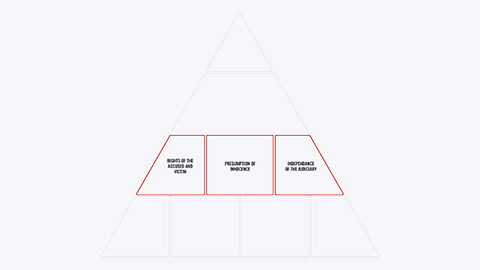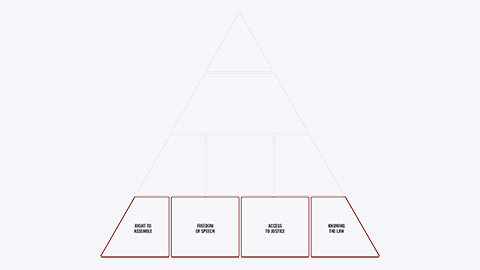Welcome to Comparative Legal Systems. In this topic, you will learn about:
- How legal systems are organised
- The components of the different types of legal systems
- Interpreting the law.
If an Australian business is going to conduct business internationally it will be exposed to legal systems that differ from the Australian system. There are approximately 200 nations in the world today; each has its own legal system. The legal system of a country is referred to as its ‘municipal’ or ‘domestic’ law system. The study and comparison of the world’s municipal law systems is called ‘comparative law’
It is possible to categorise the legal systems of the world into a number of groups, each having specific characteristics:
- Romano: Germanic civil law systems
- Anglo: American common law systems (Australia falls into this system)
- Islamic (Muslim) law systems
- Inquisitorial v adversary systems
The greatest confusion continues to prevail about what is being compared, about the purposes of comparison, and about appropriate techniques.
Myres McDougal
What is not comparative law? Comparative law is not:
- description of a foreign law
- parallel descriptions of different laws
- comparison of rules.
Before you begin, take a look at the four (4) links below:
Open this link and study the chart that indicates the different legal systems that operate in every country. You will note that some countries are a ‘hybrid’ system, meaning a combination of the systems operating in the one country.
The following site gives students access to the laws of all countries. On the left-hand menu under ‘Global’ students will see ‘All Countries’. Selecting this link will give access to all countries. Select a country you wish to research. It is suggested that students use this site as a starting point for researching their chosen country in Assessment 1. Please spend time to orient yourself with this essential website and ensure you consult your facilitator if you have any questions.
World Legal Information Institute Library
The following short video from the United States Institute of Peace explains the development and features of each of these legal systems. Please note that you will be asked to register to access this video. The video introduces the legal systems of the world. In particular, the history of the common law and civil law traditions. Take particular note of the historical timelines for the development of each legal system.
History of the Common Law and Civil Law Traditions
The following is an excellent resource that will provide you with access to business laws of all countries. Students can choose an economy and decide what information they want to research. At the bottom of the page is a button ‘Create a Report’ that will present the requested information. This report would be an excellent resource for Assessments 1 and 2.
The following table distinguishes between the different types of law. Read through the headings across the top and down the left-hand column to understand what each part of the content relates to.
| Common-Law | Civil Law | Socialist Law | Islamic Law | |
|---|---|---|---|---|
| Other Names | Anglo-American judge-made law | Continental, Roman | Communist | Religious |
| Sources Of Law | Judicial interpretation and legislation | Code | Marxist-Leninism | Sacred religious document |
| Lawyers | Control courtroom | Judges dominate trials | Party members | Secondary role |
| Judges' Qualifications | Former practising lawyers | Career bureaucrats | Party members | Religious as well as legal training |
| Degree Of Judicial Independence | High | Insulated from regime | Courts are in extension of the state | Very limited |
| Juries | Often available at trial level | Mixed tribunals in serious cases | Often used at lowest level | Not allowed |
| Policy-Making Role | Courts share in balancing power | Courts have equal but separate power | Courts are subordinate to the legislature | Courts and other governmental branches are subordinate to the shari'a |
| Examples | Australia, England, Canada, India | France, Germany, Israel, Japan, Mexico | China, Russia | Saudi Arabia, Nigeria |
International law: Public and private
International law can be public and private. Take a look at the definitions which follow to gain a better understanding.
- Public international law refers to the rules and norms governing relationships among states and international organisations.
- Private international law refers to the international rules and standards that apply to cross-border commerce.
The following video from LUND University (European Business Law: Doing Business in Europe, © Lund University) titled 'What is Private International Law?' explains how private international law can be used to resolve transnational disputes. Although the discussion relates to doing business in Europe, the comments are relevant to doing business anywhere in the world.
Actors in International Law
- Following World War II, 50 nations signed the Charter of the United Nations, whose goal was to ensure international peace and security, to encourage economic and social cooperation and to protect human rights.
- Today, 193 countries are members.
- The International Court of Justice (ICJ) is the judicial branch of the United Nations.
- The ICJ settles international legal disputes and gives advisory opinions to the UN and its agencies.
- The ICJ is comprised of 15 elected judges from 15 countries representing the world’s principal legal systems.
- Over the past 70 years, the court has heard fewer than 200 cases; it is not an important force in resolving international business disputes.
- Incoterms rules: A series of three-letter codes used in informational contacts for the sale of goods.
- International Court of Arbitration (ICA): A forum for international dispute resolution, run by the ICC.
- Sovereign immunity: Sovereign immunity holds that the courts of one nation lack the jurisdiction (power) to hear suits against foreign governments.
- Waiver: A lawsuit is permitted against a foreign country that waives its immunity, voluntarily giving up this protection.
- Commercial activity: A plaintiff can sue a foreign country engaged in commercial, but not political activity.
- Violation of international law: A plaintiff in this country may sue a foreign government that has confiscated property in violation of international law.
The ‘rule of law’ is a very important concept and provides that governments and individuals can only act in accordance with publicly known laws. These laws must be adopted and enforced in a manner that is consistent with established conventions, traditions and procedures. The rule of law provides that all citizens come within the scope of the law; no one is above the law. This means the law applies to everyone whether you are prime minister, a judge, a police officer or an ordinary citizen.
The rule of law is important because it prevents the arbitrary exercise of power. If power is exercised in an arbitrary way this can lead to harm or oppression. Citizens need to have confidence in the law and feel secure that laws will be administered in a predictable and transparent manner. Australia has a very strong rule of law.
The pyramid and fact sheet below, explains the concept of rule of law and what the rule of law means in Australia.
Whereas it is essential, if man is not to be compelled to have recourse, as a last resort, to rebellion against tyranny and oppression, that human rights should be protected by the rule of law.
Preamble to the Universal Declaration of Human Rights (1948)
The rule of law is a legal tradition in Australian society. At its simplest it requires that we have laws that are followed and enforced.

Equality before the law means that the law should apply to all people equally regardless of their status in society, rich or poor, young or old, regardless of their race, culture, religion, or any other attribute.

Where law grants powers there must be checks and balances on the use of power to ensure that the government and individuals act according to the law.

The presumption of innocence ensures individuals are punished only when found guilty. Independent and impartial judges ensure that trials are fair and, that justice is achieved for victims and the accused.

The rule of law also requires that people can speak freely about problems with the law; individuals must be able to do this without fear or persecution and be free to assemble peacefully in public. Our legal system must be accessible to all or people may think the law is useless and, the law must be knowable so people can follow it.
The following image shows how all these components fit together to create a cohesive system.

The Rule of Law Institute of Australia (RoLIA) is an independent, not for profit organisation which seeks to promote discussion of rule of law issues in Australia. It actively contributes feedback to Parliamentary Committees on proposed legislation, and provides access to education programs and resources for students studying the law.
The rule of law in Australia was part of the system of English law which was shaped by the Magna Carta in 1215. The Magna Carta was a landmark document that required checks and balances on the use of power of the king; even the King of England was not above the law according to the Magna Carta.
In Australia today, our legal system provides:
- ways to settle disputes between parties
- just outcomes when a person is accused of a crime
- protection for individuals rights
- solutions to legal problems.
The rule of law is fundamental in maintaining a free, democratic, tolerant and prosperous society.The Magna Carta articulates fundamental aspects of the rule of law that are as important today as they were 800 years ago. While the law and the needs of society change, the rule of law principle remains the same: it promotes freedom from tyranny by ensuring checks and balances on the use of power.
Please look at the different types of legal systems that are found around the world.

The world’s legal systems
- The hallmarks of common law are:
- the use of an adversarial process of dispute resolution presided over by an impartial judge
- the doctrine of stare decisis, which requires judges to base their decisions on prior cases
- the use of a jury to determine questions of facts
- stare decisis: The principle that legal conclusions must be reached after an analysis of past judgments.
- More than 70% of the world’s population is subject to civil law, including most European countries, Russia, Central and South America, China, large parts of Asia, and parts of Africa.
- The main principle of civil law is that the law is found primarily in the statute books, or codes.
- The main characteristics of civil law are:
- the use of an inquisitorial process of dispute resolution, in which the judge acts as interrogator and investigator; judges rely more on written submissions than on lawyers’ oral arguments
- courts base their judgments on the code and statutes, and on the writings of law professors
- civil code systems do not use juries.
- More than one-fifth of the world’s population lives under legal systems influenced by the religion of Islam.
- Also known as Shari’a, it is found mostly in Africa, Asia, and the Middle East.
- There is much variation in the interpretation and practice of both Islam and Islamic law.
- Shari’a is based on the Muslim holy book, the Koran, and the teachings of the Prophet Muhammed.
- A reasoning process known as ijtihad incorporates religious and legal reasoning.
- While some Islamic groups prohibit any new interpretations of Shari’a, others regularly use ijtihad to adapt Shari’a to modern-day problems.
- Payment and collection of interest is prohibited; financial investments in firms that do not align with Muslim values are also prohibited.
- Gharar: The Islamic prohibition on risk and deception.

Sources and applicability of international law
The following information lists and defines sources of international law, how foreign and domestic law interact, and what needs to be considered when choosing an applicable law and jurisdiction in international business negotiations.
Sources of International Law
- Treaty: An agreement between two or more states that is governed by international law
- GATT: GATT is the General Agreement on Tariffs & Trade
- World Trade Organization (WTO): An international organization whose mandate is to lower trade barriers
- Most favored nation: WTO/GATT requires that favors offered to one country must be given to all member nations
- National treatment: The principle of nondiscrimination between foreigners and locals
- Regional Trade Agreements (RTAs): Treaties that reduce trade restrictions and promote common policies among member nations
- North American Free Trade Agreement (NAFTA): A treaty that reduced trade barriers among Canada, the U.S. and Mexico
- General Agreement on Trade in Services (GATS): A treaty on transactional services
- Agreement on Trade Related Aspects of Intellectual Property (TRIPS): A treaty in intellectual property
- CISG: The United Nations Convention on Contracts for the International Sale of Goods:
- applies to contracts for the sale of commercial goods
- applies automatically when contracts are formed between two parties located in different signatory countries
- allows that contracting parties can opt out
- allows that international sales contracts need not be in writing
- stipulates that contracting parties must be flexible and fair
- stipulates that a buyer can avoid payment only after giving the seller notice and an opportunity to remedy.
- Customary International Law: International rules that have become binding through a pattern of consistent, long-standing behavior
- Jus cogens: When rule of customary international law becomes a fundamental legal principle across all nations, it cannot be changed by custom or practice.
Interaction of Foreign and Domestic Laws
The interaction of foreign and domestic laws can be described as recognition and enforcement of foreign judgments:
- Foreign recognition: Foreign recognition means that a foreign judgment has legal validity in another country.
- Foreign enforcement: Foreign enforcement means that the court system of a country will assist in enforcing or collecting on the verdict awarded by a foreign court
- Arbitration: Arbitration is a binding process of resolving legal disputes by submitting them to a neutral third party
Choosing the Applicable Law and Jurisdiction
When you or your organisation negotiate international deals, the following must be considered:
- Choice of law (which law governs?)
- Choice of forum (where will the case be heard?)
- Choice of language and currency.
Watch the following video which describes the role the Hague Conference on Private International Law (HCCH) plays in making international treaties that can resolve conflict of law questions such as which law applies to resolve a dispute or which court should litigation be initiated in. Take note of the examples of the conventions discussed, particularly those involving international trade and the countries who are parties to these conventions.
In the preceding video, the presenter referred to the Hague Convention on the Choice of Courts. This Convention is used to resolve which court has jurisdiction to hear litigation, arising from disputes where the parties are located in different countries. The terms ‘state’ is used to refer to countries in international law (that is, a nation state).
Open the following link and select the Instruments tab. Then select ‘Conventions, Protocols and Principles’. Skim through the list to identify the main convention, protocols and principles of the Hague Conference of Private International Law. Remember, when the term ‘state’ is used, it is referring to a country.
Hague Convention on the Choice of Courts
End of topic forum
There are forum activities for this topic. Select the ‘Forum’ at the end of your module (which can be found within your navigation menu) and follow the instructions for each question pertaining to Topic 2 within the forum.

